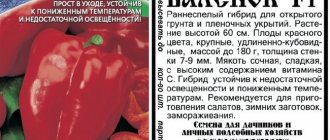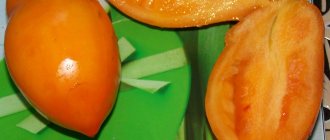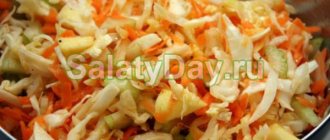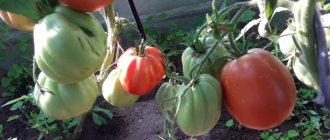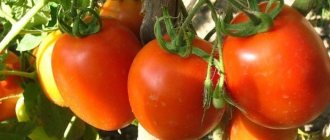The Siberian abundant tomato has firmly entered the annual assortment of vegetable growers in Western and Eastern Siberia, the Urals, the Central region and the Volga region for growing in greenhouses for early production. Its fruits have the best characteristics for fresh consumption, since they are a very early vitamin product, for canning in jars and pickling in barrels.
- Siberian abundant has a very early ripening period, from germination to the first harvest it takes from 90 to 110 days.
- Bush type - indeterminate with unlimited growth.
- Plant height reaches 1.8–2.0 m.
- In order for the bushes to develop correctly, shaping is necessary, which includes removing 2-3 main stems, tying them with cords to a common crossbar, and removing sprouts in the leaf axils - pinching.
Fruit characteristics
Siberian abundance tomatoes are rich red-crimson in color when ripe, unripe fruits are red-orange. The shape of the tomatoes is elongated-oval with a slightly pointed nose. Fruit weight is from 100 to 200 g. The first cluster is formed over 6–7 leaves, subsequent ones after one. Each cluster contains from 8 to 10 fruits. Well-developed and properly formed plants can bear up to 7 clusters. The yield of the variety is over 6 kg/bush.
Advantages of the variety
Early and friendly harvest, stable fruiting every year, remains in the greenhouse for a long time after collecting the first bunch.
How to get a high yield of Siberian Abundance
To get a high and early harvest of this variety, seeds for seedlings need to be sown at the earliest permissible time and use plant lighting. The optimal time for sowing seeds is the second ten days of February. The seedlings are transferred to the greenhouse at the end of April, where the air temperature is maintained at 24–26 o C. At night, the temperature can be lowered to 18–20 o C. Strict requirements for the level of seedling development: it must have a well-formed first cluster, which is in the full stage nominations. If this condition is met, the harvest will begin at the very beginning of June. Plants in the greenhouse are arranged in two rows with a distance between rows of 40 cm, between plants in a row - 40 cm, aisle - 70 cm.
In order for the bushes to be able to provide all the fruits set with nutrients, the plants need to be additionally fed. The best results are obtained by fertilizing with mullein infusion; 2 kg of fresh mullein are poured into 8 liters of water and infused for a week. For watering plants, this infusion is diluted 5–6 times. Tomatoes need such fertilizing every 2 weeks. In the absence of mullein, fertilizing can be done with fertilizers based on humin, amino acids and microelements or mineral fertilizers in fertilizers.
Azofoska is most suitable - it is a complex preparation in which nitrogen, phosphorus and potassium are balanced.
Stages of cultivation: from seedlings to harvest
The Batyanya variety is represented on the seed market. Since these excellent tomatoes are not a hybrid variety, gardeners can later collect seeds and propagate tomatoes themselves. Sowing of seeds should be done 60-65 days before the planned time of planting in the ground.
Important! Sowing seeds for seedlings does not need to be done too early. If you plant “overgrown” Batyanya tomato bushes in the ground, then such plants often lose the first fruit cluster, which is the most large-fruited.
Soil preparation
It is recommended to prepare the soil for seedlings in advance - it is advisable to do this in the fall. Features of soil preparation:
- the mixture should be made up of soil, humus, compost;
- You can add wood ash, potash, and phosphorus fertilizers.
Germination, picking, hardening
The first shoots appear within a week. After this, they need to be kept in a lighted place at + 24-26 ° C.
Seedlings should be picked after the appearance of the second pair of true leaves.
Plants can be transferred to a greenhouse or garden beds after 55-60 days. 2 weeks before this, it is necessary to harden the seedlings: every day for 10-15 minutes you need to bring boxes with plants from a warm room into fresh air or open a window for ventilation.
Landing in the ground
Young tomato bushes are planted in the ground according to a 50 x 40 cm pattern. Planting density is 2-3 bushes per 1 sq.m. To obtain a high yield, the crop is formed into 1–2 stems. The stepson under the lower flowering brush is used as a second growth point. Many gardeners note that it is possible to form 3 stems.
In order for the Batyanya tomato to please with its harvest, it is necessary to provide the plants with fertile soil
This is especially important to do in small plots with a small usable area and where crops are planted in one place every year. The Batyanya variety produces large yields in well-drained areas with light soil.
Acidic soils must be limed beforehand.
Advice! The best predecessor plants for Batyanya tomatoes are cucumbers, onions, carrots, and cereals. It is not recommended to plant tomatoes in an area where zucchini, potatoes, and other nightshade crops previously grew.
Care after landing
To plant seedlings, you should choose a well-lit, windless area.
It is important to provide ventilation in the greenhouse, especially on hot days. The first fruits ripen 90-95 days after the seedlings appear
This is a rather rare characteristic for such a large-fruited crop, which makes the variety very attractive for cultivation.
After planting seedlings in a permanent area, plant care is as follows:
- stepsoning;
- loosening the soil;
- mulching;
- weed removal;
- feeding with fertilizers;
- tying stems and brushes;
- timely but moderate watering;
- protection from diseases and pests.
Batyanya is a branched variety with powerful bushes, so pinching should be carried out constantly, regularly removing lateral branches. About a month before the end of the season, the top also needs to be trimmed. This will allow those fruits that still remain on the bushes to successfully reach maturity.
Important! As fertilizing, you need to alternate mineral fertilizers with organic ones. In total, 5-6 feedings are needed per season
Conclusion
If you take an interest in the reviews of summer residents who have had experience growing Batyanya tomatoes, you can see the whole range of impressions, from disappointment to delight. This range of opinions is due to how correctly the care of the crop was organized. After all, not only the yield and size of fruits, but also their taste depend on the creation of optimal conditions.
Advantages of varieties of Siberian selection
The Siberian Abundant tomato variety was bred by breeders who used pure genetic lines for crossing that are resistant to adverse weather factors. It is intended for regions with a short summer period and is recommended for cultivation in greenhouses and open ground (in more southern regions). Reviews from vegetable growers about this variety are mostly positive. They indicate that this variety is preferable to growing in a greenhouse, where its fruits ripen first among other cultivated varieties. The first 2-3 clusters bear fruit in abundance.
Features of growing tomatoes in the Siberian regions
The climate in this part of Russia is harsh and unpredictable, although the only thing that can be predicted for sure is a short and rather cold summer. Therefore, gardeners have to try hard to grow something with their own hands. Breeders are constantly working to create varieties that are able to bear fruit and produce a good harvest in such conditions.
Of course, the first and main requirement that is placed on them is the rapid ripening of fruits. Therefore, preference is given to early-ripening and early-ripening varieties that are capable of growing green mass, achieving their final growth and development, and most importantly, producing a harvest that reaches its ripeness before the short summer ends.
For open ground, low-growing varieties are chosen that do not require pinching, and in the presence of a modern polycarbonate greenhouse installation, and even a heated one, the choice expands significantly.
Description of the variety
Tomatoes have a beautiful, neat shape with a rich red color. They have an average weight, one fruit weighs up to 200 grams. The variety is tall, the length of the bush reaches two meters. They are famous for their early and high harvest. When planted normally, tomatoes will ripen as early as July. One bush grows up to 5 kilograms of tomatoes. 5-6 branches are formed on the stem, each branch contains 8-10 tomatoes.
Tomatoes have a pleasant aroma and good taste: they are moderately sweet and juicy. The pulp with a lot of juice contains almost no seeds. The skin is hard, it protects the fruit from cracks and damage. That is why the Siberian Abundant variety is well suited for pickles and preparations.
The variety is preferably grown in a greenhouse to achieve better results. However, it is noted that in the southern regions of the country, where summer comes early, tomatoes also grow well. For the central part of Russia, it is better to plant in a greenhouse or greenhouse.
Growing
The variety is grown from seeds. Seeds are planted in the spring, 60 days before transplanting into the greenhouse. To eliminate infection, seeds and soil are disinfected. Dilute a weak solution of soda or permanganate and soak the seeds in it for half an hour; after soaking, the seeds are washed with plain clean water. Place the soil in a microwave oven and turn it on for 2-3 minutes at a power of up to 800 W; you can also sprinkle the soil with soda or potassium permanganate.
Now you can plant the seeds. Make grooves in the ground 2 centimeters deep, place a seed there and retreat 3 centimeters to the next one. Plant the entire bag in this way. Tomatoes love warmth; the optimal temperature for growing them is 24-23 degrees. Light also stimulates the growth of tomatoes. Tomatoes need 12-14 hours of light. It is better to install a source of additional lighting. It is important to remember that early sowing does not mean early harvest. An early harvest is achieved by fulfilling all conditions: watering, fertilizing, transplanting seedlings, lighting and temperature.
Reviews from gardeners
Most people have only good words about this variety.
Maria from the Moscow region said: “I planted it last year, the seedlings all took off well. The bushes grew two meters tall, the bush was full of ovaries, and the harvest exceeded all expectations. There were a lot of tomatoes, we even had to distribute them to neighbors and treat colleagues. They taste good, but I used them more for salting. This year I will definitely plant, but less.”
Olga from Omsk says: “An excellent variety of tomatoes! It’s not fussy at all, I didn’t fertilize the soil much, but it didn’t affect the tomatoes at all. On the contrary, they bloomed early, and the tomatoes themselves began to gain color at the beginning of summer. I made a vegetable stew from the fruits, added them to lecho, salted them, pickled them, and even froze some of them. By the way, they freeze well due to their thick skin and do not tear or burst. I really like the variety, I will definitely continue to grow it.”
Care
Timely true care is important. All bushes need scheduled feeding. Humus is added to the soil, but not fresh, but settled or last year’s, so as not to heat the root system and destroy the seedlings. You can distribute manure in the following proportions: 2 kg of the substance, get 8 liters of water and leave for at least a week. This fertilizer can be fed to plants every 2 weeks. At least feed with substances containing amino acids, trace elements and mineral supplements. The product azofosk will do. It contains all the necessary fertilizers for tomatoes: nitrogen, phosphorus and potassium.
Every week you should remove weeds, loosen the soil and build a small mound near the stem. In this way, the plant forms new origins and has more access to fertilizers and watering. The soil should be moistened under the stem, without getting on the leaves. After irrigation, there is no need to loosen the soil or even sprinkle it dry so that a crust does not form.
Description and characteristics of the Siberian Izobilny tomato variety, reviews, photos
Early, productive, indeterminate, tall, cluster tomato variety. Recommended for growing in the middle zone in greenhouses, in the southern regions - in open ground.
A bush with a regular leaf, up to 1.8 meters high, requires tying to a support and pinching. The best result is when the plant is formed into 2-3 stems. The fruits grow in clusters, 8-10 pieces each. An adult plant usually has up to 7 racemes.
Basic qualities of fruits
The fruits are elongated-oval, smooth, dense, red-crimson in color at maturity, weighing 100-200 grams, good taste. These tomatoes are suitable for fresh consumption and for all types of processing.
The variety produces an early harvest and also ensures stable and long-term fruiting, regardless of weather conditions.
We recommend sowing the seeds of this tomato variety for seedlings 60-65 days before the intended planting in the ground.
Tomatoes suitable for both greenhouses and open ground
There are varieties of tomatoes that can be grown both in open and closed ground. The most popular and famous include:
King of Siberia
The stepsons are removed without fail, and at the same time 2 main stems are left.
This is one of the largest-fruited varieties, producing a harvest of giant tomatoes weighing up to 1 kg.
The shape of the fruit resembles a heart and is ideal for preparing salads, main and first courses, all kinds of sauces and pastes.
Rugby
An excellent early variety that produces a harvest 90–95 days after planting. It is characterized by high yield - up to 18 kg per 1 m2 of dense, smooth, bright red fruits with excellent taste and excellent keeping quality. This determinate, high-yielding hybrid is resistant to many diseases, including Alternaria and TMV.
Welcomes regular watering and fertilizing with mineral complex fertilizers, especially during the period of fruit set. "Rugby" makes excellent salads and autumn preparations, and it is also often grown for sale.
Bulls-eye
Just by the name alone, it is clear that we are talking about cherry tomatoes, small, but capable of forming up to 15 clusters consisting of 20 fruits on one plant. Each such fruit weighs from 20 to 40 g, ideal for canning. Such a crop can provide you with tomatoes for the whole season, and also become part of the decoration of your garden plot.
When grown in a greenhouse with 1 m2, you can harvest up to 20 kg or more of tomatoes that are resistant to pests and most diseases, capable of maintaining their thin skin and elastic pulp intact under any circumstances.
Siberian abundant
This tomato of northern selection is adapted to unfavorable weather conditions and is able to bear fruit both in a greenhouse and in an open area. Many vegetable growers note that, compared to other varieties, it is one of the first to form clusters and set fruit. They appear 90–110 days after planting and are distinguished by their red-crimson color and elongated oval shape with a slightly pointed tip.
Up to 7 clusters can form on one plant, which makes it possible to collect more than 6 kg of fruit from one bush. Moreover, the variety bears fruit early and bears fruit consistently and consistently every subsequent season.
Abakan pink
This variety is loved and known in all regions, and in Siberia it has especially many admirers. It is classified as an early ripening plant, capable of producing a harvest already on the 115th day after planting. Bushes are characterized by determinacy, although reviews of the possible height vary significantly. They need to be tied up and stepsoned at least once every 3 days.
This variety is distinguished by pink, fleshy pulp, and the fruits themselves can reach 500 g. From 1 m2 you can harvest about 5 kg of tomatoes, which is considered a great success for a non-hybrid. The yield of the crop largely depends on care, timely application of fertilizers, watering, loosening, mulching, etc.
Tomato variety Siberian abundant on video
If you grew the Siberian Abundant variety, please write whether you liked them or not. What was the yield and taste of the fruits like under your climatic conditions? How do you rate the disease resistance of this variety? Briefly describe the advantages and disadvantages of this tomato in your opinion. If possible, attach a photo of your tomatoes to your comment. Thank you!
Your reviews of the Siberian Abundant tomato and additions to the description will help many gardeners evaluate this variety more objectively and decide whether it is worth planting or not.
- Author: Maria Sukhorukikh
Rate this article:
- 5
- 4
- 3
- 2
- 1
(0 votes, average: 0 out of 5)
Share with your friends!

